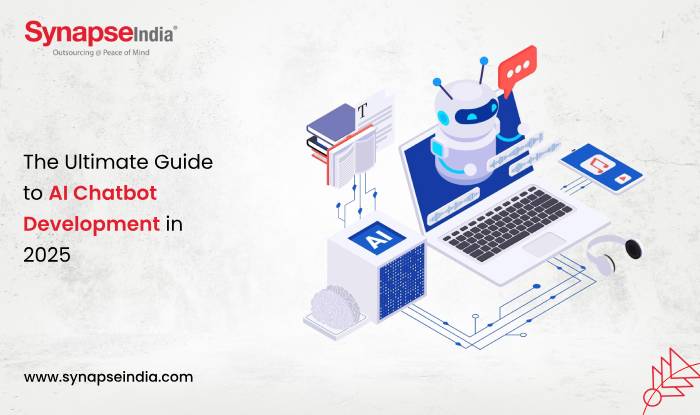 11 Apr 2025
11 Apr 2025“Explore the growing world of AI chatbots in 2025. Learn how they boost business efficiency, cut costs, and reshape customer support across industries with smart, personalized automation.”

With the increasing demand for AI chatbots, the need for companies that build them has gone up as well. Businesses want to have their own bots to make daily operations easier and more efficient.
There have been major improvements in AI chatbot development. These changes are shaping the way businesses connect with their customers and how users interact with different platforms.
This guide gives a full picture, covering what’s happening in the market, how the technology works, the steps involved in creating a chatbot, and where things are headed next. The information is based on solid research, including market reports, user feedback, and industry insights.

The AI chatbot market is growing steadily, with different research reports showing slightly different numbers.
Grand View Research places the market size at USD 7.76 billion in 2024, with a projected growth rate of 23.3% CAGR. This would bring the market to about USD 9.57 billion by 2025.
Mordor Intelligence estimates it to be USD 8.71 billion in 2025, while Demandsage (2025) gives a higher figure of USD 10.32 billion.
Taking all three into account, a balanced average lands around USD 9.6 billion for 2025.
Some important figures show how widespread chatbot usage has become:
These numbers show that chatbot use is becoming more common. It’s also helping save time; businesses have reportedly saved up to 2.5 billion working hours by using chatbot systems, as noted by Demandsage (2025).
AI chatbots are software applications designed to simulate human-like conversations through the use of artificial intelligence. These are not the same as traditional rule-based chatbots, which depend on pre-written responses and follow fixed scripts.
AI chatbots work with advanced technologies such as Natural Language Processing (NLP), Machine Learning (ML), and deep learning to better understand and respond during conversations.
With all these elements working together, AI chatbots can respond in a way that feels more natural and useful. They offer a much more refined experience compared to earlier systems, which were often rigid and limited in their capabilities.
AI chatbots are changing how businesses work by offering:
This applies across different areas. E-commerce platforms, healthcare services, and financial institutions are all seeing strong outcomes. In healthcare, 78% of professionals say chatbots help with appointment bookings. In banking, 80% of institutions say chatbots improve client service, again supported by Tidio, 2024.
Businesses that use these smart tools, especially when shaped to fit industry needs, are already experiencing the results.
Building an AI chatbot follows a simple step-by-step structure, making it easy to understand, even for those without a technical background:
The first step is to clearly decide what the chatbot is expected to do. It could be something like answering customer queries, assisting in sales, or managing bookings. Knowing the purpose helps set the right direction.
Next comes selecting the right platform. Options include Dialogflow, Microsoft Bot Framework, IBM Watson Assistant, Amazon Lex, Rasa, or Wit.ai. Each one has its own strengths. For example, SynapseIndia prefers tools that align with business needs and user behavior.
Once the platform is selected, the flow of conversation needs to be mapped. This means planning out possible user questions and the chatbot’s responses. It’s important to think through how the conversation will feel simple, helpful, and clear.
With the flow ready, the chatbot gets developed and trained using actual data. Feeding it with high-quality, varied datasets helps it respond better over time.
Testing with real users is important. It helps spot gaps or confusing answers. Based on the feedback, the chatbot is fine-tuned to improve its accuracy and response style.
After testing, the chatbot is launched. From there, it’s important to keep an eye on how it performs, how people interact with it, what works well, and what might need fixing.
Best results come from starting with a focused plan, covering the most common questions, and making sure there’s always a way for users to reach a human if needed. These small steps make the overall chatbot more effective and easier to use.
Modern AI chatbots come packed with practical features that make interactions smoother and more natural.
These chatbots can remember what was said earlier in a conversation. This helps them respond in a way that makes sense based on the flow of the discussion. It avoids repetitive questions and builds more human-like interactions.
They don’t just stick to one platform. Whether it’s a company’s website, a Facebook page, or a mobile app, these bots can operate across all of them. This helps keep the communication consistent, no matter where the user is interacting.
Reaching out to users who speak different languages is no longer a challenge. These bots are built with the ability to understand and respond in multiple languages. That means global users can get help in the language they’re comfortable with.
Everything users do with a chatbot can be tracked and measured. These bots gather data from conversations to show what’s working and where there’s room for improvement. This helps businesses tweak the bot’s performance over time.
Data privacy matters. Modern bots stick to rules like GDPR and HIPAA, especially when dealing with sensitive information. This keeps user data protected and builds trust.
Some bots are designed for specific tasks like booking a ticket or checking order status. Others are built for broader conversations, like virtual assistants such as Siri or Google Assistant.
We design and develop these kinds of AI chatbots, depending on what the use case demands. Each type serves its own purpose, and the choice depends on what the chatbot needs to achieve.
Leading chatbots in 2025 include:
Top platforms for development are Dialogflow, Microsoft Bot Framework, IBM Watson Assistant, Amazon Lex, Rasa (open-source), and Wit.ai (free, multi-language). Each provides tools to build and run chatbots, enabling custom workflows, language understanding, and integration with different applications.
AI chatbots benefit sectors like:
Challenges include:
By 2025, trends include:
These trends aim to make chatbots more intuitive and integrated, changing how customer interactions are handled across industries.
Choosing SynapseIndia as an AI chatbot development company makes sense for businesses that want practical solutions backed by experience. We build custom chatbots using tools like Dialogflow, Microsoft Bot Framework, Amazon Lex, and others; always based on what suits the business goal and user experience.
Each chatbot is carefully designed, with conversations mapped out, tested with real users, and improved based on feedback. These bots aren’t just built to answer questions; they’re trained with quality data, so they get better over time. From rule-based bots to ML-powered systems and hybrids, every type is supported depending on the use case.
Features like multilingual support, omnichannel availability, and context awareness help create interactions that feel more natural. Data security and analytics are also part of the package, ensuring that user data stays protected and the chatbot continues to improve.
Everything we build is shaped by real-world business needs and strong technical understanding.

AI chatbot development in 2025 brings a wide range of opportunities for businesses aiming to improve how customers interact and how tasks are managed internally. The field is growing fast, both in terms of market demand and the technologies behind it. This guide includes everything needed to understand the current state of AI chatbots, from how the market is expanding to what technical progress means for practical use.
For businesses considering AI chatbot solutions, SynapseIndia provides AI Chatbot Development Services. The service includes planning, designing, and building chatbot systems that match specific business needs. These solutions help improve the way customer interactions are handled and contribute to overall growth.
To begin with a chatbot solution, connect with SynapseIndia for more details.


